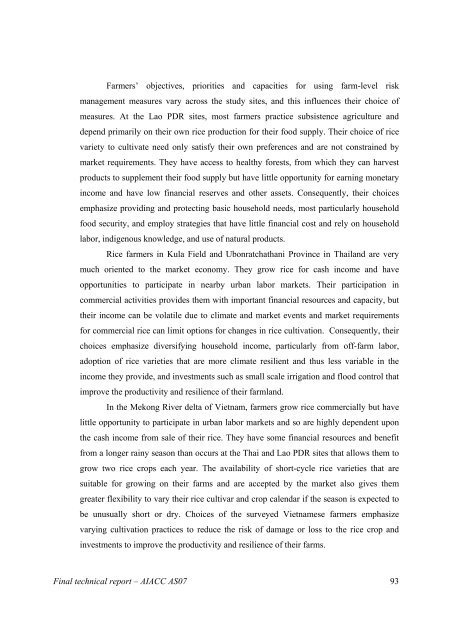Final Technical Report - weADAPT
Final Technical Report - weADAPT
Final Technical Report - weADAPT
- No tags were found...
Create successful ePaper yourself
Turn your PDF publications into a flip-book with our unique Google optimized e-Paper software.
Farmers’ objectives, priorities and capacities for using farm-level risk<br />
management measures vary across the study sites, and this influences their choice of<br />
measures. At the Lao PDR sites, most farmers practice subsistence agriculture and<br />
depend primarily on their own rice production for their food supply. Their choice of rice<br />
variety to cultivate need only satisfy their own preferences and are not constrained by<br />
market requirements. They have access to healthy forests, from which they can harvest<br />
products to supplement their food supply but have little opportunity for earning monetary<br />
income and have low financial reserves and other assets. Consequently, their choices<br />
emphasize providing and protecting basic household needs, most particularly household<br />
food security, and employ strategies that have little financial cost and rely on household<br />
labor, indigenous knowledge, and use of natural products.<br />
Rice farmers in Kula Field and Ubonratchathani Province in Thailand are very<br />
much oriented to the market economy. They grow rice for cash income and have<br />
opportunities to participate in nearby urban labor markets. Their participation in<br />
commercial activities provides them with important financial resources and capacity, but<br />
their income can be volatile due to climate and market events and market requirements<br />
for commercial rice can limit options for changes in rice cultivation. Consequently, their<br />
choices emphasize diversifying household income, particularly from off-farm labor,<br />
adoption of rice varieties that are more climate resilient and thus less variable in the<br />
income they provide, and investments such as small scale irrigation and flood control that<br />
improve the productivity and resilience of their farmland.<br />
In the Mekong River delta of Vietnam, farmers grow rice commercially but have<br />
little opportunity to participate in urban labor markets and so are highly dependent upon<br />
the cash income from sale of their rice. They have some financial resources and benefit<br />
from a longer rainy season than occurs at the Thai and Lao PDR sites that allows them to<br />
grow two rice crops each year. The availability of short-cycle rice varieties that are<br />
suitable for growing on their farms and are accepted by the market also gives them<br />
greater flexibility to vary their rice cultivar and crop calendar if the season is expected to<br />
be unusually short or dry. Choices of the surveyed Vietnamese farmers emphasize<br />
varying cultivation practices to reduce the risk of damage or loss to the rice crop and<br />
investments to improve the productivity and resilience of their farms.<br />
<strong>Final</strong> technical report – AIACC AS07 93
















